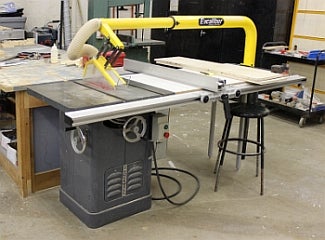Description and uses
The table saw is useful for ripping planed, jointed, and engineered lumbers along their length. It can also be used to crosscut wood using a mitre gage. The blade can be angled for beveled cuts up to 45 degrees off perpendicular. Advanced cuts like rabbets and dadoes can be performed, but require the guard to be removed (see the woodshop technician if you need to perform any advanced blades function). The table saw is chiefly used to size panels and widths of long lumber.
Ripping through lumber
The blade should be raised until the bottom of the saw blade troughs reach the top surface of the lumber. This height insures the maximum cutting ability of the teeth and the most efficient clearing of chips and dust. The fence must be used and locked in place, when ripping. The width can be gauged by the witness lines provided on the fence guide. Your hand should never be within six inches of the blade nor should you ever push the material in such a way that your hand or body could travel in the path of the saw blade. Never position yourself directly behind the workpiece. Use a push stick when the path of the cut places your hands in harm's way.
Start the machine with your material flat on table. Move the workpiece into the blade in a controlled, continuous motion, guiding the wood along the fence. Maintain the motion until the lumber clears the table. Shut off saw and remove cut-offs from the table.
Cross-cuts through lumber
Raise the blade as in the ripping operation. Mark you material and hold it firmly against the mitre gage. While saw is off, slide material into the path of saw to gauge the position of the cut. Back the material away from the blade to begin your cut. Start the machine and use both hands to hold the material firmly against the mitre gage and feed into the blade until the material is cut through. Stop the saw and remove the material and the cut-off. The mitre gage can also be used to make angled cuts.
Further considerations
- Blade should be checked for tightness.
- Check the blade guard and splitter for proper operation.
- Verify location of on/off switch and/or emergency power disconnect.
- If used, check to ensure that the fence is set properly and tight.
- Ensure that the table is clear of material, tools, and debris.
The Table Saw must have a blade guard and splitter installed. Some operations require you to remove the guard: This can only be done with the approval and supervision of the woodshop technician. The guard must be immediately re-installed immediately once the special cuts are completed.
The fence and mitre gage must never be used together. Use the fence for ripping and the mitre gauge for crosscutting. Many crosscuts can be made safely on other saws such as the panel saw (up to 5 feet), the compound mitre saw (up to 12 inches).
Push sticks, feather boards, hold downs, etc. must be used whenever an operation is performed that would require the operators hands to pass within 6 inches of saw blade.
The operator should stand behind and slightly to the left side of the wood as it is being fed through.
No piece of wood that is smaller that 11 inches long is permitted. The smaller the piece the more dangerous the operation.
No piece of wood may be cut "freehand", without a fence or mitre gauge. This action will lead to kickback and injury.
Table saw hazards
"Kick Back" occurs for a variety of reasons, and is one of the primary reasons for all table saw injury. The most common instance occurrs when the board being cut does not have at least one straight, true edge to push up against the fence. Another common occurrence arises when the wood is not flat or is warped causing the material to bind. Indeed, some woods have internal pressures that are released when they are cut, twisting the wood and causing kickback ( as often occurs when cutting heart wood). Cross-cutting with the fence is extremely hazardous.
"Dust Hazards" are produced by many woods and materials when their dust is airborne and inhaled, providing a toxicity and cancer risk. Some woods are more toxic than others, such as cedar, pressure treated woods, and teak. The glues associated with plywoods, particleboard and MDF contain formaldehyde and have been shown to be toxic.
Foreign objects in the wood itself pose a threat, such as nails, screws, stones, wire etc. Not only are they potentially injurious to the operator, they do damage to the machine surface, fence, and the carbide blade. All materials that are cut on the table saw must first be vetted by the wood shop technician to ensure that they are suitable for cutting and free of foreign objects.
Cautions
- Eye protection is mandatory.
- Ear protection is required for prolonged use.
- A dust mask or active dust collection is recommended for plywood and particleboard and required for MDF and certain toxic woods.
- Only operators trained in the safe operation of a table saw are allowed to use the saw.
- Never start machine with blade touching workpiece.
Table saw
